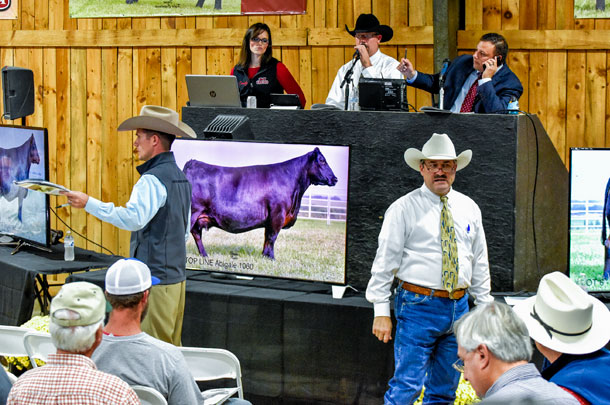Production sales can be overwhelming. There are lots of moving parts and people behind the scenes that have to synchronize to execute the event. But with a little foresight, your family or business partners can successfully plan a production sale with minimal headaches.
In today’s market, you can choose a live in-person event, private treaty bidding or an internet sale to showcase your offering. There are pros and cons to each, along with an array of costs. We can’t tell you which sale type is right for your operation, but we can walk you through it from a marketing standpoint. The basic principles remain the same, regardless of the size of your sale.
3 to 6 months in advance:
- Choose a sale date and location
- Contact all sale staff
- This includes your auctioneer, sale manager, ring help, buyer representatives and the online bidding platform of your choosing. Sign any necessary contracts at this time.
- Announce sale on social media and website
- Get this information on the internet ASAP to ensure website visitors and social media platforms display the info in an obvious location.
3 months in advance:
- Decide how many animals will sell
- Register the cattle
- Be sure to allow plenty of time for DNA results, genetic testing and ultrasound data to come back from the lab.
- Create an advertising plan and budget
- This includes catalog costs, print advertising, social media advertising or TV or radio spots depending on the location and size of your sale. Be sure to get an estimate or quote for each person you hire so there are no surprises.
- There are several ways you can reach out to both returning and new customers, and you will have to spend some money in advertising to get people to your sale. Some options include the following: direct mail for catalogs or postcards, e-blasts (state cattlemen’s organizations, sale hosts and breed associations offer these services), social media and local advertising (consider hanging up flyers in gas stations, at shows, in sale barns, etc.). Make your graphic designer aware of all planned advertising.
- Book photographer, videographer and graphic designer
- All livestock professionals have the same busy season. Be sure to contact them early and ask when they need all the materials. Some catalogs need to be printed up to 60 days before sale day, and photographers and designers must work together to get everything edited, designed and proofed in a timely manner. Bad weather can also delay pictures – so allow time for flexibility.
- Videos are also a huge part of production sales. We recommend having a separate video day two to three weeks before the sale to give potential buyers the most accurate look at the cattle, as they will change a lot in a short time frame.
2 months to 6 weeks in advance:
- Clip and torch cattle
- Picture cattle for the catalog
- Determine catalog order and write footnotes
6 weeks in advance up until sale day:
- Reach out to customers
- All it takes is a phone call, text message or an email. You can also send out sale catalogs to your contacts with a quick, handwritten note. Always invite them to look at the cattle in person too.
- Update website and social media ASAP
- Sale dates, catalogs, videos, online bidding platforms and supplemental information all need to be published. Post on both social media and your website to ensure it can be found easily.
- On social media, share your favorite lots, sire groups or sale highlights. Be sure to include links to the catalog and videos, and invite followers to ask questions and come see the cattle in person as well.
Using a professional gives many advantages to selling cattle. For example, an experienced livestock photographer is able to get the best possible shots to market your cattle to your customer base. As they say, “a picture is worth a thousand words,” or in the livestock world, that can mean thousands of dollars.
Our number one tip is to make sure you have enough help on picture day and try to get some experienced help to work in the picture pen. That will make the whole day go better. For production sales with photos only, if the cattle are cooperating and everyone keeps working, 50 to 75 head is more than possible. It’s a team effort on picture day.
Leading up to the sale, a sale manager or designated person within your organization will often help coordinate an advertising schedule. Dates such as when the catalog needs to go to the printer and what ads are due for which publications should be included. You will also need to be regularly checking email to proof all ads. Remember, graphic designers are working on several projects all at once too, so send ad due dates as far in advance as possible.
On a more personal level, you should be using social media to make your followers aware of your sales and share any pertinent information, as well as a behind-the-scenes look at preparations. Because of the cattle buyer’s demographic, we focus our efforts around Facebook at this time. A good guideline is to post two to three times per week to be sure your posts are being seen by as many people as possible, without becoming repetitive or annoying and therefore irrelevant to potential buyers.
There is real value in hiring a professional to help with production sale preparation. Cattlemen have hundreds of things to worry about, and ad deadlines and other marketing strategies are probably not at the top of your list. ![]()
PHOTO: The auctioneer, sale manager and the sale staff take bids during the ZWT Annual Production Sale in Crossville, Tennessee. Photo courtesy of Focus Marketing Group Inc.








